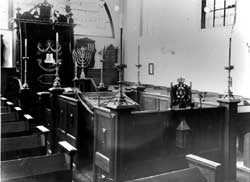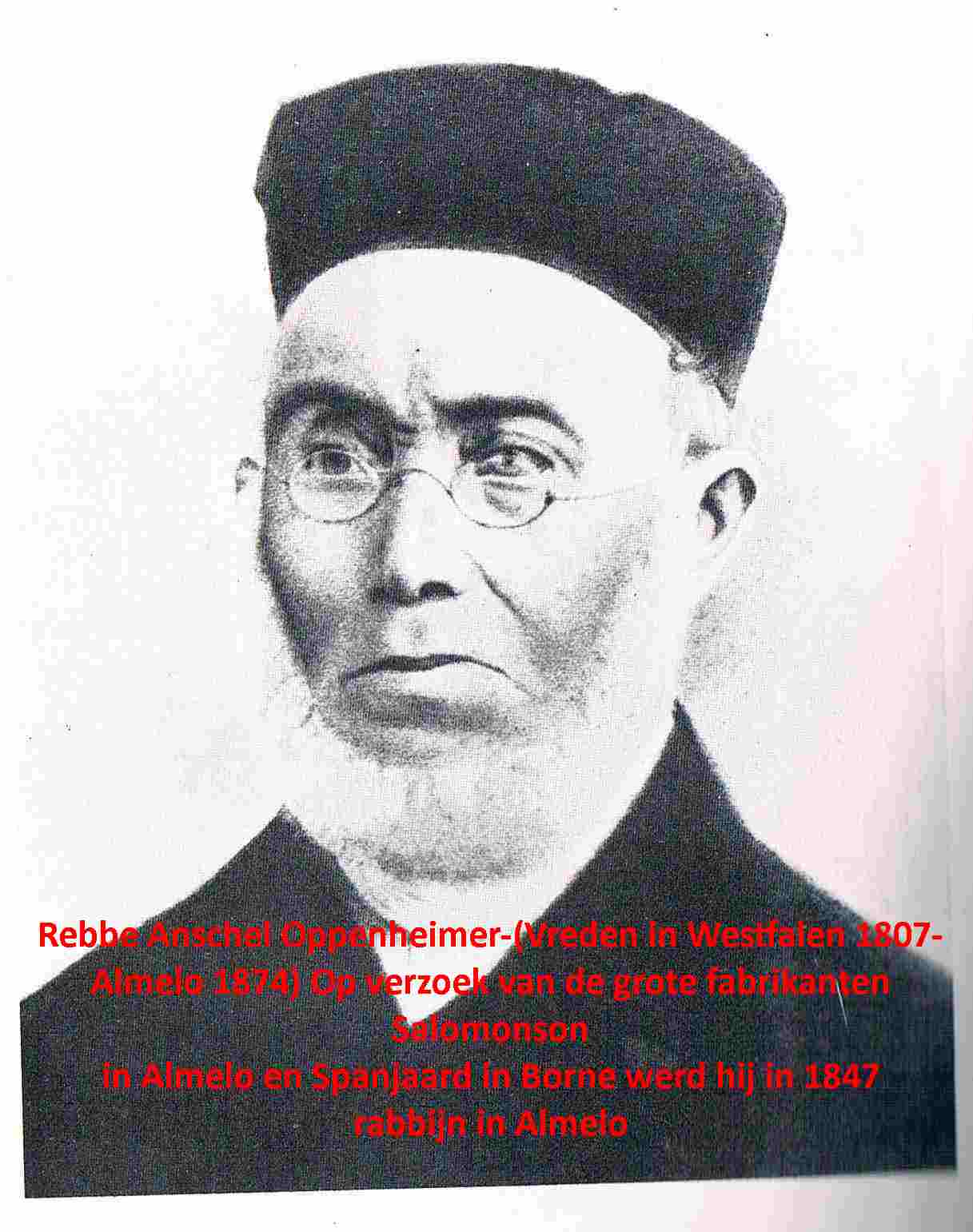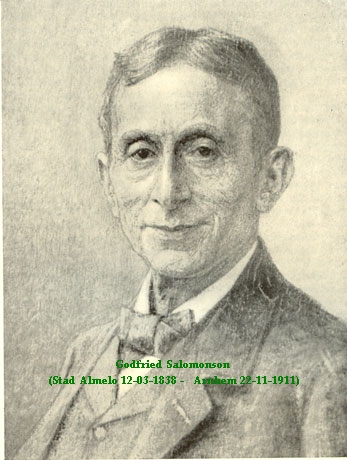The Jewish community of Almelo
History
The history of the Jews in Almelo dates back to the 17th century. The first known Jew, mentioned in our sources, was Isaac Arents, living in Almelo in 1660. During the eighteenth century Jewish names often appear in documents. In 1772 seven male Jews lived in Almelo, including Abraham Moses, already mentioned in 1731. Their number increased during the time. Towards the end of the eighteenth century the Jewish community of Almelo had become a medium-sized community, according to Dutch Jewish standards.
The main growth of the community took place in the nineteenth century, as a result of the economic growth and development of the town and surroundings.
In the middle of the nineteenth century a study group, named "Talmud Torah," was established by the rabbi, rabbi Anschel Oppenheimer, a well known Talmudic scholar (1807-1874). Rabbi Oppenheimer, also named Anschel of Almelo, hailed from Vreden in Germany. He traded in spices and lived in Almelo from 1847 till 1874 where he was very influential. He was the rabbi, the teacher and the mohel and during his years in office he persuaded many Jews to become members of the community.
The church council and societies
The church council consisted of seven members. There was a society for the poor and a treasurer for the Holy Land. The society for the poor "Gemilus Chasodiem" was established in 1855. Other societies in Almelo were the study group "Mekour Chajiem," established in 1888, the women society "Nosjiem Zadkonious," from 1860, the youth movement "Tiferes Bachoeriem," from 1852, and another woman society "Lechovoud Ulesiferes," from 1890.
These societies provide an indication of the flourishing Jewish life in Almelo in the middle of the 19th century, with emphasis on the care for the poor. At the start of the 20th century we find in Almelo, besides the well-to-do, also many poor and needy people (70 from the 562 in 1901).
In 1916 the Dutch Jewish Community also established a society with the name of "Gemilus Chasodiem". There were therefore two societies with the same name and purpose. In our sources we could not trace any further information regarding the previous society, founded in 1855. The newer society - from 1916 - was responsible for the care of the ill, the dying, and the needy. From the start of the 20th century immigrants and refugees from Eastern Europe were absorbed by a special society, "Hachnosas Ourechim."
Other societies were dedicated to social and cultural purposes and from 1930 there was also Zionistic activity. The Zionist youth movement "Hazoriem" counted seventeen members at the end of the thirties, and there was a group of orthodox Palestine pioneers, organized in "Dat wa-Arets." Members of the Society of Professional Education of Palestine pioneers, also called "the Deventer Society," received their agricultural training in the surroundings of Almelo. The members of this society maintained contact with the "Chaluziem movement" of Deventer.
Synagogue
The old synagogue, known to be situated in the Bodden in the year 1803 - the year of foundation is unknown - became too small for the growing community. New premises were found at the Schalderoi, which were entirely renovated in 1860. These premises however had to be left, as a result of a restoration planned by the Almelo municipality. The building was sold to the municipality on the condition that the municipality would provide proper accommodation for the Jewish community. In 1971 the municipality renovated the school building opposite the old synagogue, for synagogue services and meetings of the Jewish community. When this building also had to be demolished, the Reformed church offered accommodation.
Although the synagogue survived the war without a scratch, thanks to the Almelo municipality, which claimed the building for potato storage, it had become too large and also difficult to heat, so it was not too hard to leave the building.
The new synagogue was built in the old style of the adjoining buildings of the Kerkplein. The interior of the Schalderoi synagogue found its place in the new synagogue. The Aron Hakodesh was restored and installed. The Torah rolls, hidden in Amsterdam during the war, were returned. The expense of the new synagogue was born for 2/7 by the Jewish community and the remainder was paid by the government.
Since 1999 the synagogue bears the name of Aron Haas, as a sign of honor to him, in appreciation of the moving power he showed during the restoration of the Jewish community of Almelo after the war.
Cemetery
The first old cemetery dating from 1775, situated at the Sluitersveld near the Kerkhofweg was closed and a new one was established in 1845 at the Boddenstraat.
Jewish school
Not much is known about Jewish education in Almelo. During the 19th century the children received Jewish schooling and in 1926 a new school building was employed.
Industry
The Jews played an important part in the textile industry, which was well known in this part of the Netherlands. The most important industrialists were Mozes, Joseph and Gottfried Salomonson. In 1796 Mozes Salomon obtained the right to live in town and in 1812 he changed his family name to Salomonson.
His sons founded the firm of G and H Salomonson and by 1835 they had acquired a well known reputation in the export of cotton products. In 1852 they founded the Koninklijke Stoomweverij in the neighboring village of Nijverdal, which thanked its industrial development to this factory.
The firm Bendien founded the damask industry in Ootmarsum and moved afterwards to Almelo. Isaac Bendien started his career as a peddler and became the founder of the clothing industry in Almelo.The firm of Heideman should also be mentioned as one of the most important textile manufacturers.
After the war
The greater part of the Jewish inhabitants of Almelo did not return from the camps; from the 265 deported only six returned. 160 Jews were hidden during the war and survived.
After the war the Jewish community of Almelo was reinstated and it remained active for a long time. From 1945 till 1970 L.F. Israels was the teacher of the community. He schooled a number of young people to take their place in the synagogue or in the community, as cantor or Jewish teacher.
After the war the Nederlands Israelitische Gemeente Almelo also included a number of former small communities like: Gramsbergen, den Ham, Hardenberg, Hellendoorn, Ootmarsum, Rijssen, Vriezenveen and Wierden.
Source:
Pinkas Hakehillot-Encyclopedia of Jewish Communities
The Netherlands-Yad Vashem
1985
ISBN: 965-308-000-8
Extracted from source:Yael Benlev-de Jong
Translation into English:Mechel Jamenfeld
Editing:Ben Noach
Final review:Hanneke Noach
[an error occurred while processing this directive]
[an error occurred while processing this directive]
 The Synagoge |
 |
 |